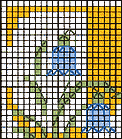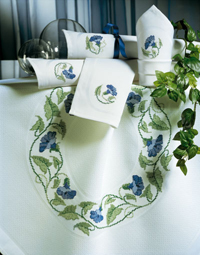Needlecraft Techniques - Cross Stitch

|
Cross stitch is the best-known type of colour embroidery and is one of the oldest existing embroidery techniques. In folk art world wide there are traditional cross stitch patterns that differ not just in shape and colour but also in technique.
Cross stitch charts are usually illustrated with squares, in colours or with symbols representing colours.
|
For example, some cross stitches are formed on both the right and wrong fabric side, or there are cross stitches on the right side and box stitches on the wrong side. In our latitudes the stitches on the wrong fabric side are kept vertical as often as possible. Fabric types: Recommended fabrics: AIDA CLOTH a special weave with intersecting groups of threads that form clear holes, or stitch squares. Ideal for children to learn cross stitch on are 3611 BINCA (2.5 squares per cm or 6 per inch), 1006 AIDA 8 count (3.2 squares per cm) There are also fine Aida cloth types such as 3793 AIDA 18 count (7 squares per cm) on which very artistic cross stitch can be worked and 3251 AIDA 16 count (6 squares per cm) are the best for fine works. 1007 AIDA 11 count (4.3 squares per cm) and 3706 AIDA 14 (5.4 squares per cm) are the most popular stitching range. All these fabrics have in common the fact that the number of squares is clearly defined and that counting single threads is not necessary. Plus, thread ends can be neatly worked in on the back. If you are looking for a quick needlework project, patterned tablecloth fabrics with Aida cloth areas are available. Tableware fabrics are available for cross stitch motifs already woven in. It could not be simpler – all you do is embroider over the motifs. Ready-made table centre cloths, runners, tablemats and serviettes/napkins are available with Aida cloth areas, e.g. tablewares such as WESTERLAND with a large, square centre. The damask centre tablecloth RONDO has a round Aida cloth area in the centre and LOTUS. For a quick gift the SONATE and AMELAND serviettes or napkins with approx. 5 cm (2 inches) Aida cloth areas are just the thing. AIDA Band Embroidery thread: |










